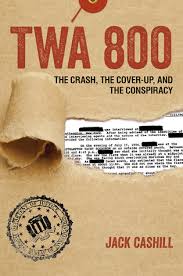The Big Lie in Jay-Z’s Trayvon Series: Part V
Jack Cashill's Big Lie in Jay-Z's Trayvon Series:
![]()

Order Jack Cashill's latest book, TWA 800: The Crash, the Cover-Up, and the Conspiracy
![]()

About Silenced: Flight 800
and the Subversion
of Justice (DVD) -
-Buy the Silenced DVD-
![]()
© Jack Cashill
August 29, 2018 - WND.com
Watching Shawn “Jay-Z” Carter’s six-part documentary series, “Rest in Power: The Trayvon Martin Story,” one gets a sense of what the Moscow show trials of the 1930s must have been like.
The prosecutors—in this case, the producers—remove almost all exculpatory evidence and add the testimony of a dozen or so ideologues who to this day have no idea what they are talking about.
Oh yea, and then they throw in at show’s end an inflammatory montage of George Zimmerman’s adjustment problems post-trial and call it a day. That is TV justice in the BLM era.
In this fifth episode, viewers get to see what are presumably the highlights of the trial. What they do not get to see, however, are the real highlights, most notably the testimony of Jonathan Good.
Prosecutors called Good as a witness only because they had to. If the State had not called him, the defense surely would have. A thirtyish college graduate who worked in finance, Good calmly destroyed the state’s case.
On the night of February 26, 2012, the altercation between Zimmerman and Martin ended up right on Good’s doorstep. He uniquely had a light on in the back. His testimony was worth more than all the other witnesses, eye or ear, combined.
Several other eyewitnesses had already testified, as artfully steered by the defense, that Good was the only eyewitness to step outside and address the combatants.
Of all the witnesses too, Good was the most succinct and coherent. He kept his testimony clinical and dispassionate. He betrayed no obvious sympathy for Zimmerman or Martin.
Yet the longer Good remained on the witness stand, the more problems he created for the prosecution. Observed Andrew Branca in Legal Insurrection, “The testimony of State witness Jonathan Good was remarkably, almost shockingly, destructive to the State’s theory of the case.”
Exploiting the rule of “completeness,” O’Mara took the opportunity to read back to Good what he told investigator Chris Serino immediately after the shooting:
“So I open my door. It was a black man with a black hoodie on top of the other, either a white guy or now I found out I think it was a Hispanic guy with a red sweatshirt on the ground yelling out help! And I tried to tell them, get out of here, you know, stop or whatever, and then one guy on top in the black hoodie was pretty much just throwing down blows on the guy kind of MMA-style.”
To repeat, “MMA-style” means mixed martial arts. O’Mara continued:
O’MARA: OK. And do you stand by that today, that what you saw was a Ground-and-Pound event?
GOOD: It looked like that position was a Ground-and-Pound type of position, but I couldn’t tell 100 percent that there were actually fists hitting faces.
O’MARA: But you did see [reading] “the guy in the top in the black hoodie pretty much just throwing down blows on the guy kind of MMA-style.”
GOOD: Meaning arm motions going down on the person on the bottom. Correct.
In confirming the accuracy of his early statements, Good validated Zimmerman’s version of the event and established beyond any reasonable doubt that it was Zimmerman who was yelling out for help.
In his cross-examination, O’Mara raised one issue with Good that most trial observers overlooked: Martin had no apparent intention of stopping his assault on Zimmerman.
In response to a question from O’Mara, Good recalled that he had said to the pair, “What’s going on? Cut it out. Stop.” O’Mara then asked, “[Martin] kept on doing what he was doing?” Again, without obvious emotion, Good affirmed that he had.
The implication was that if Good’s threat to call 9-1-1 could not slow Martin down, nothing Zimmerman could say or do would stop him either, nothing that is save shooting him.
The media had no excuse for not anticipating Good’s testimony. Good had talked to an Orlando TV station the day after the shooting. “The guy on bottom who I believe had a red sweater on was yelling to me, ‘help, help,’” Good told the reporter. “I told them to stop and I was calling 911.”
For reasons of their own, the media chose to keep alive the increasingly pointless debate as to who was the source of those screams.
The producers showed just one word of Good’s testimony. Prosecutors asked him if he had seen Zimmerman shimmy off the concrete sidewalk, as Zimmerman claimed, and Good said, “No.” That was it.
Almost as conspicuous by its absence was defense attorney Mark O’Mara’s literal show-stopper. Between the end of Zimmerman’s call to the dispatcher and the first of 9-1-1 calls, four minutes elapsed.
Had Martin wanted to get away he could easily have run a half-mile in that time. Instead, he circled back to the spot where Zimmerman ended his call and attacked him.
O’Mara, at Zimmerman’s suggestion, let the jury experience how long four minutes is by doing and saying nothing for four minutes. True to form, the producers did not even hint at the four-minute hole in the prosecution’s “narrative.”
“You got to give them a narrative,” says MSNBC’s Joy-Ann Reid. “I think the prosecution utterly failed.”
Sorry, Joy-Ann, but there was no narrative to give them. In court, at least, the accused gets a defense. The prosecutors could not get away with the shameless nonsense of “Rest in Power.”
____
Jack Cashill's Big Lie in Jay-Z's Trayvon Series:

Jack Cashill is the author of If I Had A Son: Race, Guns, and the Railroading of George Zimmerman.
